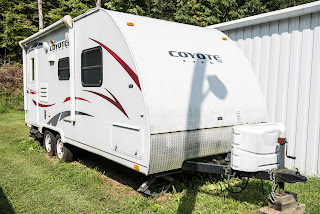Solar Eclipse
I do not live in the path of totality, but had some opportunity to experience the recent solar eclipse. It meandered (at about 1,800 miles an hour) across the lower forty-eight recently.
I decided to take a few pictures, but I did so at the last possible moment, so I had to use such items as I had on hand at the time. To shoot the eclipse, I knew I would need to allow as little light as possible into my camera. In the end, I wish I had remembered one additional setting that might have helped me. Nonetheless, I got a couple of interesting shots, and some very valuable experience.
Here are the shots I like best. They are more of the full sun than they are of the eclipse, but they are notable to me due to the unexpected ability I had to take photographs revealing some detail of the sun itself.
Notice the small black dot in the lower right quadrant of the corona. I think this may be the International Space Station. The reason I think so is that it is in a different location in the next image.
In the image above the ISS is in the lower left quadrant. Notice also that I have achieved a better exposure in this image. This is due to adding 5 stops of neutral-density gels to the front of the lens. This gave me the sunspot detail in this and the following image.
Here the eclipse had just begun. Note the sunspots again.
We got 88% coverage here, and this shot is a bit before the maximum coverage. My images of maximum have problems in that the ends of the crescent show as doubled. I have no idea why.
Camera settings: Nikon D810 - 1/8000th, f/45, ISO Low 1.0 (One stop below ISO 64). 70-200mm f/2.8 lens with a 2x telextender, which costs 2-stops of light and yields a 400mm result. Added 5 stops of ND gels to the front of the lens.
I wish I had remembered that the camera has a +/- EV setting. I could have set that to underexpose another 3-4 stops.
I decided to take a few pictures, but I did so at the last possible moment, so I had to use such items as I had on hand at the time. To shoot the eclipse, I knew I would need to allow as little light as possible into my camera. In the end, I wish I had remembered one additional setting that might have helped me. Nonetheless, I got a couple of interesting shots, and some very valuable experience.
Here are the shots I like best. They are more of the full sun than they are of the eclipse, but they are notable to me due to the unexpected ability I had to take photographs revealing some detail of the sun itself.
Notice the small black dot in the lower right quadrant of the corona. I think this may be the International Space Station. The reason I think so is that it is in a different location in the next image.
In the image above the ISS is in the lower left quadrant. Notice also that I have achieved a better exposure in this image. This is due to adding 5 stops of neutral-density gels to the front of the lens. This gave me the sunspot detail in this and the following image.
Here the eclipse had just begun. Note the sunspots again.
We got 88% coverage here, and this shot is a bit before the maximum coverage. My images of maximum have problems in that the ends of the crescent show as doubled. I have no idea why.
Camera settings: Nikon D810 - 1/8000th, f/45, ISO Low 1.0 (One stop below ISO 64). 70-200mm f/2.8 lens with a 2x telextender, which costs 2-stops of light and yields a 400mm result. Added 5 stops of ND gels to the front of the lens.
I wish I had remembered that the camera has a +/- EV setting. I could have set that to underexpose another 3-4 stops.





Comments
Post a Comment